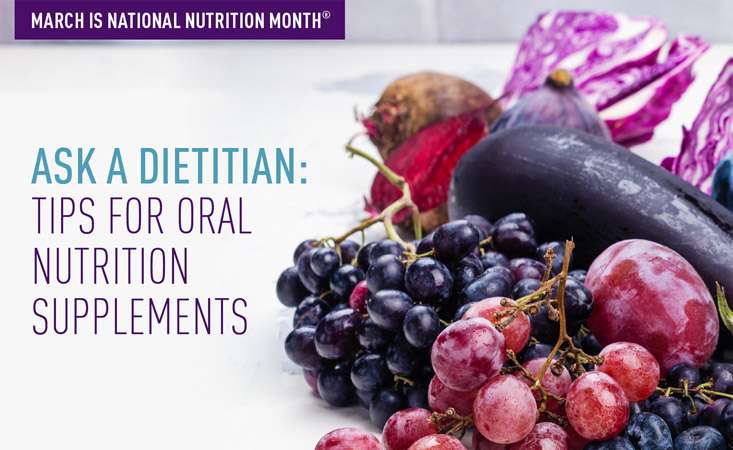
Patients with pancreatic cancer sometimes face loss of appetite, changes to taste and smell and other nutritional challenges that can make it hard to maintain their quality of life. Oral nutrition supplements – available in many grocery stores in liquid and powder form – are one way to boost caloric and fluid intake and add nutrients to a patient’s diet. Here, in the second of our three-part series for National Nutrition Month®, Colleen Gill, MS, RDN, CSO, a registered oncology dietitian, speaker and author, talks about why oral supplements are helpful and ways patients and their caregivers can use them.
What are some of the reasons patients with pancreatic cancer may want to use oral supplements?
The main reason I recommend oral supplements to most of my patients is that they are convenient and easy to use for those who are often too tired to eat. They have the added benefit of emptying out of the stomach more easily than solids. Many patients with pancreatic cancer have problems with delayed gastric emptying, making them feel full, further affecting their ability to eat a significant amount of food. Oral supplements can help cope with loss of appetite.
Are there certain types of supplements/replacements you recommend for pancreatic cancer patients?
I like to encourage a variety of oral supplements. They can be used as a snack between meals, added to a main meal or even replace a meal, depending on the calories and nutrition they offer. For patients on pancreatic enzyme therapy, any oral supplement with fat will need to be accompanied by enzymes to avoid malabsorption. Many people mistakenly treat them differently than solid foods, but fat of any sort needs enzymes traveling with it through the digestive tract. When the pancreas is not able to put out enough enzymes to break down your food, supplemental prescription enzymes can fill in that gap.
There are the standard supplements like Boost (Nestle) or Ensure (Abbott), or their generic counterparts. These come in a variety of types, but I typically recommend the plus version since it provides more calories, with a similar amount of protein as the high protein option. Experiment with different flavors and don’t buy too many of any one flavor before you’re sure you like it. These oral supplements can also serve as a base for smoothies, with fruit, ice cream, etc. added for variety.
Milk-based supplements are another option. I recommend that patients look for a higher calorie base to add them to, moving from skim milk to 2% for example, to take advantage of the extra calories. Carnation Breakfast Essentials is one option for powders. Some others will advertise “30 grams of protein,” primarily geared for people wanting to add muscle, but typically with limited calories. The extra protein is not helpful if there aren’t enough calories available to meet your body’s energy needs.
Juice-based products like Bolthouse Farms, Odwalla and Naked Juice provide variety and are helpful as long as you use the options that have a significant amount of protein. These are found in the refrigerated section of the store, often just adjacent to the produce area. Patients often like these as a change of pace from milk-like drinks.
Clear liquid options, such as Ensure Clear and Boost Breeze, will be fat free, including only protein and sugar, and consequently lower in calories. They may be better tolerated at times when fat is slowing down how quickly the stomach is emptying.
What are some recipes involving oral supplements or ideas for incorporating supplements into the diet?
I use soups as well as drinks for liquid oral supplements. Puddings can also be an option. Some patients prefer hot versus cold foods and find soups helpful. Many grocery stores now sell prepared/gourmet soups made in house, or from local restaurants.
I’ll share a couple of recipes that patients of mine and their caregivers have found helpful.
Here’s a recipe for a warm, savory smoothie soup that includes approximately 28 grams protein and 360 calories (more with veggies).
For the base:
- In your blender, place ½ cup instant non-fat dried milk powder
- 2 cups soy milk, cow’s milk or Lactaid
- If you want to use chicken or vegetable broth instead of milk, add in 1 cup dried milk powder. This version will have less calories.
Add 2-3 choices from the vegetable groups below to make a delicious, high-protein, warm smoothie soup!
- 1 cup cooked carrots
- 1/4 cup cooked cauliflower
- 1/4 cup cooked broccoli
- 1/2 cup pureed white beans
- 1/4 cup butternut squash
- Add seasonings such as onion powder, turmeric and cinnamon
- (A tablespoon of oil will add another 120 calories)
And here’s one more warm supplement idea – for an easy microwave custard. It’s four servings and provides 230 calories and 11 grams of protein:
- 1 cup whole milk
- ½ cup heavy cream
- ¼ cup dry milk powder or protein powder
- 3 eggs, slightly beaten
- 1/4 cup sugar
- 1/8 teaspoon salt
- 1 teaspoon vanilla
- Nutmeg
Heat milk and cream in bowl in microwave on high for 2-4 minutes (hot, but not boiling).
Blend the eggs, sugar, salt, and vanilla. Whisk the egg mixture into milk. Pour into 4 custard cups. Sprinkle with nutmeg and microwave at 50% power (medium) for 6-10 minutes until set.
Try these yourselves or share with a friend. One thing I always advise is that patients and caregivers give specific directions, like recipes, to friends and family who want to help. It prevents them from ending up with trays of casseroles they may not even like. And friends truly want to know how to best help and are relieved by specific ideas, such as a recipe for a soup or smoothie.
Patients should always consult with their doctor or registered dietitian before making any changes or additions to their diet. PanCAN strongly recommends that patients have access to pancreatic enzymes and see a registered dietitian.





